A Comprehensive Framework for Direct Lightning-Structure-Human Interaction Modelling in Heritage Monuments and Safety Assessment
Abstract
:1. Introduction
2. Formulation of Framework for Modelling and Analysis of Lightning-Structure-Human Interaction and Electrical Safety Hazards
3. Modelling and Implementation of Lightning-Structure-Human Interaction Scheme
- Standard current wave shapes as stipulated in IEC 62305 namely 0.25/100 µs, 1/200 µs and 10/350 µs
- Cloud potential in the range of 30 MV to 50 MV
- Variations in wetness in the range of 20%, 40% and 60% for the case studies
- Earthing electrode with a length of 3 m and radius of 3 cm
- The soil resistivity of top layer considered as red soil with resistivity (ρ) during dry condition is160 Ωm and during wet condition is 25 Ωm
- The soil resistivity of the second layer considered as clay soil with resistivity (ρ) during dry condition as 240 Ωm and during wet condition as 37.5 Ωm
- Structure material is considered to be granite
- Human body model with a height of 1.8m
3.1. Modelling of LPS for Heritage Monument
3.2. Modelling and Implementation of Heritage Structure during Lightning Strikes
3.2.1. Estimation of Electric Field and Lumped R-L-C Parameters of Structure
3.2.2. Modelling of Depth of Penetration during Lightning Strikes
3.3. Modelling of Earthing System during Lightning
3.3.1. Modelling of Depth of Penetration during Lightning Strikes
3.3.2. Modelling of Resistivity of Soil Layers
Single Layer Model
Double Layer Model
3.4. Implementation of Lightning Stroke Model for Simulation of Voltage and Current Waveshapes
3.4.1. Generic Aspects of Lightning Impulse generator Modelling
3.4.2. Modelling and Implementation of Marx Impulse Generator as per IEC 62305
3.5. Human Body Model
3.5.1. Touch Potential
3.5.2. Step Potential
4. Observations and Analysis of Lightning-Structure-Human Interaction Modelling for Heritage Monuments
4.1. Analysis of Zone of Protection
4.2. Analysis of Impact of Skin Depth
4.3. Analysis of Importance of Soil Resistivity and Lumped R-L-C Earthing System
Touch Potential
- It is evident during studies that as the wetness levels increase the impedance (hence the resistance and reactance) of the structural and earthing equivalent models also consequently undergoes changes. The magnitudes of peak current observed through the gopuram and earthing system increase with increasing wetness. This aspect of increasing wetness attribute to the lowering in the value of resistance and impedance whereby leading to larger currents through the structure earthing equivalent model.
- From the context of varying waveshapes, it is also evinced that increased current through the structure and earthing system during higher levels of wetting is attributed to time (hence, frequency) of the impulse waveshape. With waveshapes of lesser time period, as the frequency is obviously higher, the total impedance of the structure and earthing system is reduced, thereby leading to higher currents through it.
- It is also observed that there was a minor increase in the ground current in the case of double layer soil resistivity model as compared to its single layer counterpart. Since the double layer model inherently utilizes R-L-C parameters of the soil modelled as two parallel layers, its equivalent resistance value is observed to be lower. It is hence evident that a more conservative strategy for earthing modelling and system is to utilize the double layer model approach. However, it is important that the parameters related to the site condition (soil type, inhomogeneity, resistivity, etc.) are accurately made available before undertaking the modelling and analysis task, as incorrect estimates of such parameters may lead to substantial human hazards.
4.4. Analysis of Impact of Lightning strike on Structure for Human
4.4.1. Touch Potential
- From the standpoint/viewpoint of heating effect and energy dissipation considerations on human during lightning, it is evident that due to effective earthing arrangement, the energy is of the order of 80 J to 2 kJ for human equivalent model at 60% wetness. It is found to have had a maximum impact for single layer soil model as compared to its double layer counterpart. Table 11 compares the role of waveshape on its energy capability during lightning-human interaction.
- It is also evident from this analysis that the impact of lightning on human becomes extremely insignificant only as long as an effective earthing system based on exhaustive analysis of single-layer and double-layer soil models is carried out. Subsequently, the low magnitudes of energy dissipated clearly indicate the role played by an effective earthing system in ensuring safety of human in such heritage installations.
- It is also specifically observed in R-L-C earthing system models during lightning-human interaction that underdamped oscillations of voltage and current responses occur. Figure 24a,b depicts typical responses that exhibit such underdamped oscillations for a lightning current waveshape of 10/350 µs.
- It is inferred that sustained oscillations occurring in the range of 500 kHz to 1000 MHz for about a few microseconds may lead to dielectric power losses in the human body. Since human body comprises fluids which could undergo polarization due to dipole moments, such spinning of dipoles at higher frequencies may cause internal injuries to tissues and culminate into muscular contractions and deformities. Similar such studies [29] have been carried out by researchers for ascertaining power loss and breakdown voltage in fluids (air and oil). Such studies in liquid (oil) indicate frequencies in the range of 10 kHz to 100 kHz with high dielectric loss. These similarities clearly establish the role of higher order frequencies in breaking the covalent bonds in liquid dielectrics leading to higher heating and increased dielectric power loss. Through simulation studies which validate this aspect, it would be essential to establish this claim; it is evident from the results indicated in Figure 24a,b that the high-frequency response of current through human would certainly be a cause of concern and endanger human safety.
4.4.2. Step Potential
4.5. Analysis of Overall Lightning-Structure-Human Interaction
- Based on the existing LPS design implemented in the heritage structure taken up for detailed studies in this research, it is evident from Figure 17a that the shielding effectiveness during lightning strike with current strokes of magnitudes of even 100 kA is insufficient. Hence, it is obvious that structure and human are potentially endangered due to incorrect and ineffective LPS leading to severe hazards. However, during the analysis, as indicated in Figure 17b, due to additional lightning rods proposed to be implemented on the corners of parapet wall of the main vimana, a more robust, reliable, and effective shielding is ensured. Table 13 establishes the effectiveness of the modified and enhanced LPS zone of protection whereby ensuring the overall safety to structure and human. The analysis indicates that total expected number of failures per year is estimated to be 3.713 × 10−3, which is 269.3 years between consecutive failures
- From the context of structural safety aspect, it is obvious that effective earthing system is mandatory to prevent large damages to heritage properties. This is even more important when tall structures have relatively sharp edges and corners (inevitable in heritage monuments due to decorative sculptures) which clearly establish the need for suitable earthing system.
- The effectiveness of earthing and earthing system in addition to soil resistivity models plays a significant role in ensuring human safety aspect. Observations summarized in Table 12 clearly establishes this fact since magnitudes of current of order of 3 kA to 8 kA are likely to flow into the human body (touch potential) when earthing of the heritage structure is not effective.
- Another major concern related to human safety relates to several devotees and tourists who tend to congregate and rest in the close vicinity of such a large structure, thereby getting exposed to higher step voltages than the tolerable threshold limits. Such dangers could become more rampant when makeshift shelters are close to such heritage structures. This aspect is reiterated and justified in Table 13.
5. Conclusions
- It is significant to note that the entire modelling is based on the premise that accurate values of structural properties of the heritage monument such as permittivity (dielectric constant) of rock, mortars, etc., conductivity (resistivity) of structure and soil, precise dimensions of the monument etc., are prerequisites for reliable and effective analysis and implementation. Hence, correlation of the role of skin depth of the structure would be a challenging proportion. In this study a relatively correlatable measure on the extent of damage is made evident. This aspect requires more thorough and detailed studies with more case studies of similar damages in other heritage structures so as to ascertain and validate this claim.
- It is important as a first yet vital step to ensure that a highly effective shielding zone during LPS implementation based on IEC 62305 is implemented. This, in fact, would virtually obviate the need for additional protective measures at a later point during maintenance and upkeep of the heritage facility.
- It is also evident from the detailed studies and analysis that the double layer soil model is more appropriate to ascertain the extent of ground currents during a lightning strike as it clearly indicates a safer path for earthing large currents during such strikes. However, practically, this model would be appropriate in locations which exhibit a heterogeneity as indicated in soil texture of specific locations and hence becomes relevant only in specific cases. From the viewpoint of a more onerous condition, it is practical to assume a larger resistance (impedance) during lightning, as this would ensure that higher risk is evaluated. Also, ensuring exceptionally low grounding resistance becomes a complex task due to space and ergonomic constraints in an existing heritage structure. It is pertinent to note that modification in the vicinity of age-old structures is invariably prohibited by governmental and archaeological agencies since such structure may include rare artifacts, idols, sculptures, other treasure, etc.
- From the perspective of human safety wherein it is particularly important to ensure that the values of both step and touch potentials are to be within tolerable limits, this study clearly emphasizes the need for safe distance (at least 10 m away from the structure) to be maintained by the tourists and devotees visiting such heritage structure to clearly obviate the danger and risk of ground potential rise during lightning strikes. It is suggested that humans are given a separate shelter or resting place away from such tall structures to prevent mishaps during such strikes. It would also be more appropriate to implement an alarm annunciator system, so that the tourists are moved away from the access of such structures which are prone to lightning risk.
Author Contributions
Funding
Data Availability Statement
Acknowledgments
Conflicts of Interest
References
- Cooray, V. An Introduction to Lightning; Springer: Dordrecht, The Netherlands, 2015. [Google Scholar]
- Wetter, M.; Kern, A. Number of lightning strikes to tall structures—Comparison of calculations and measurements using a modern lightning monitoring system. In Proceedings of the 2014 International Conference on Lightning Protection (ICLP), Shanghai, China, 11–18 October 2014. [Google Scholar]
- Accidental Deaths & Suicides in India; National Crime Records Bureau, Ministry Home Affairs, Government India: Mahipalpur, India, 2015.
- Singh, O.; Singh, J. Lightning fatalities over India: 1979–2011. Meteorol. Appl. 2015, 22, 770–778. [Google Scholar] [CrossRef]
- Ioannidis, A.I.; Mikropoulos, P.N.; Tsovilis, T.E.; Kokkinos, N.D. A Fractal-Based Approach to Lightning Protection of Historical Buildings and Monuments: The Parthenon Case Study. IEEE Ind. Appl. Mag. 2022, 28, 20–28. [Google Scholar] [CrossRef]
- Tsintskaladze, G.; Sharashenidze, T.; Gabunia, V.; Beridze, G. Actions of factors caused by lightning on historical and cultural monuments and the possibilities of their prevention on the example of Abuli fortress. Int. J. Latest Eng. Manag. Res. (IJLEMR) 2019, 4, 92–97. [Google Scholar]
- Fisher, C.E. Lightning Protection for Historic Structures; 50 Preservation Briefs; Government Printing Office: Washington, DC, USA, 2017; pp. 1–20.
- Sreedhar, S.; Venkatesh, S. Lightning strokes and its effects on histor- ical monuments, heritage properties and important landmarks a detailed perspective of traditional and scientific methods of lightning protection systems. Int. J. Eng. Technol. 2018, 7, 784–794. [Google Scholar] [CrossRef]
- Lightning Arrester Averts Major Damage to Big Temple Gopuram, DTNEXT. 6 June 2018. Available online: https://www.dtnext.in/News/TamilNadu/2018/06/06020148/1075055/Lightning-arrester-averts-major-damage-to-Big-Temple-.vpf (accessed on 20 February 2021).
- Srinivasan, V.; Fernando, M.; Kumara, S.; Selvaraj, T.; Cooray, V. Modeling and assessment of lightning hazards to humans in heritage monuments in India and Sri Lanka. IEEE Access 2020, 8, 228032–228048. [Google Scholar] [CrossRef]
- Venkatesh, S.; Thirumalini, S.; Chandrasekaran, S.; Sreedhar, S.; Kakria, K.; Fernando, R.; Kumara, J.R.S.S. Three-dimensional implementation of modified rolling sphere method for lightning protection of giant medieval Chola monument in South India. In Proceedings of the 14th Conference on Industrial and Information Systems (ICIIS), Kandy, Sri Lanka, 18–20 December 2019; pp. 535–540. [Google Scholar]
- IEC 62305; Part 1 to 4. Protection Against Lightning. International Electrotechnical Commission: London, UK, 2006.
- Cooray, G. Vernon. In The Lightning Flash; No. 34; IET: London, UK, 2003. [Google Scholar]
- Mithra, J.; Baskaran, R. Soil classification and land capability of Thanjavur taluk, Thanjavur district, Tamilnadu–India. Int. J. Curr. Res. 2016, 8, 40161–40164. [Google Scholar]
- IEEE 998; IEEE Guide for Direct Lightning Stroke Sheilding of Substations. IEEE: Piscataway, NJ, USA, 2012.
- Horvath, T. Understanding Lightning and Lightning Protection: A Multimedia Teaching Guide; Wiley: Hoboken, NJ, USA, 2006. [Google Scholar]
- Mariscotti, A. Self and mutual capacitance of conductors in air and lossy earth with application to electrified railways. Arch. Electr. Eng. 2019, 68, 859–873. [Google Scholar]
- Gomes, C.; Kadir, M.Z.A.A.; Izadi, M.; Gomes, A. Lightning current and voltage distribution of large axially symmetric buddhist stupa in Sri Lanka. In Proceedings of the 2014 International Conference on Lightning Protection (ICLP), Shanghai, China, 11–18 October 2014; pp. 1637–1651. [Google Scholar]
- Cooray, V. Lightning Electromagnetics; Institution of Engineering and Technology: London, UK, 2012. [Google Scholar]
- Cooray, V. Lightning Protection; The Institution of Engineering and Technology: London, UK, 2009. [Google Scholar]
- Mohamad, N.N.; Abdullah, S. Comparison between utility sub-station and imitative earthing systems when subjected under lightning response. Int. J. Electr. Power Energy Syst. 2012, 43, 156–161. [Google Scholar] [CrossRef]
- IEEE Std 80-2013 (Revision of IEEE Std 80-2000/Incorporates IEEE Std 80-2013/Cor 1-2015); IEEE Guide for Safety in AC Substation Grounding. IEEE: Piscataway, NJ, USA, 2015; pp. 1–226. [CrossRef]
- Wadhwa, C.L. High Voltage Engineering; New Age International: New Deli, India, 2006. [Google Scholar]
- Tomoaki, N.; Watanabe, S. Postured voxel-based human models for electromagnetic dosimetry. Phys. Med. Biol. 2008, 53, 7047–7061. [Google Scholar]
- King, R.W.P. A review of analytically determined electric fields and currents induced in the human body when exposed to 50-60-Hz electromagnetic fields. IEEE Trans. Antennas Propag. 2004, 52, 1186–1192. [Google Scholar] [CrossRef]
- Kantartzis, N.V.; Amanatiadis, S.A.; Alrim, V.A.; Christos, S. Antonopoulos. Accurate electromagnetic field exposure characterization due to mediated lightning strikes via an efficient finite-difference time-domain based human body model. IET Sci. Meas. Technol. 2016, 10, 124–129. [Google Scholar]
- IEC 60060; Part 3, Definitions and Requirements for On-Site Testing. International Electrotechnical Commission: London, UK, 2006.
- Selvaraj, T.; Srinivasan, V.; Raneri, S.; Fernando, M.; Kakria, K.; Jayasingh, S. Response of Organic Lime Mortars to Thermal and Electrical Shocks Due to Lightning Strikes. Sustainability 2020, 12, 7181. [Google Scholar] [CrossRef]
- Saravanan, S.; Rajesh, R.; Karthikeyan, B.; Venkatesh, S. Dielectric Integrity Test- A Tuned Circuit Approach. In Proceedings of the 2006 IEEE 8th International Conference on Properties & applications of Dielectric Materials, Bali, India, 26–30 June 2006; pp. 380–383. [Google Scholar] [CrossRef]




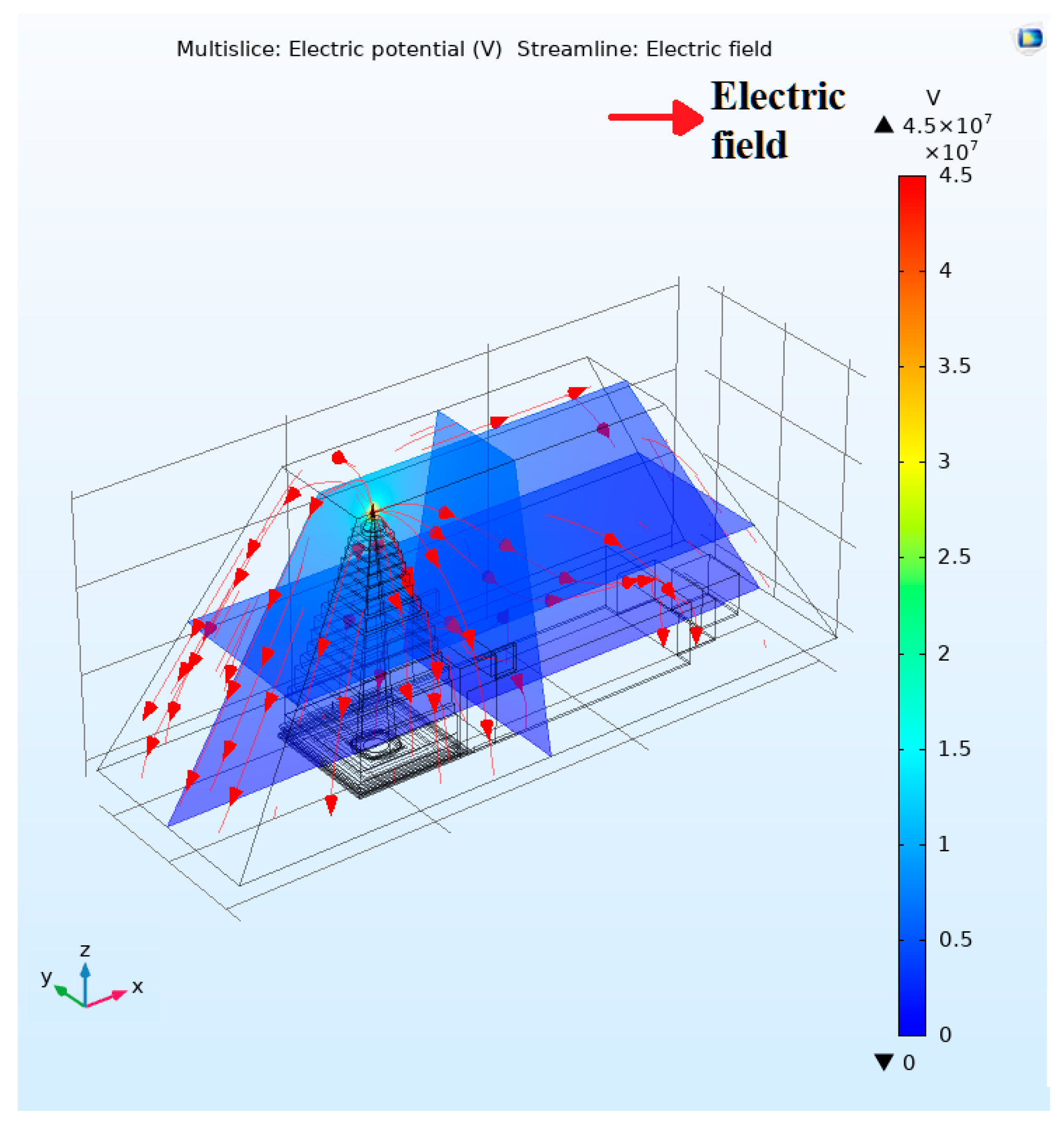
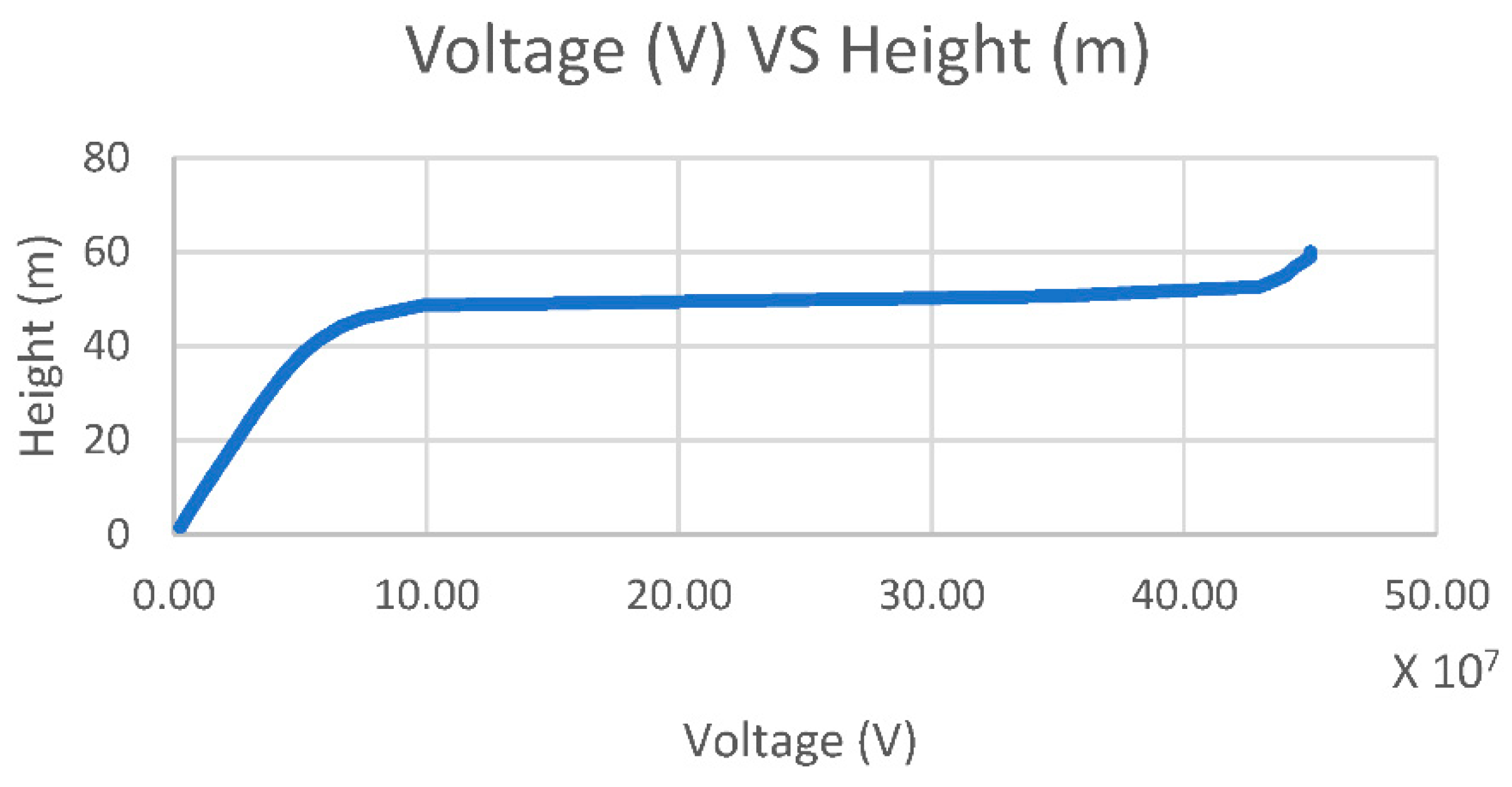
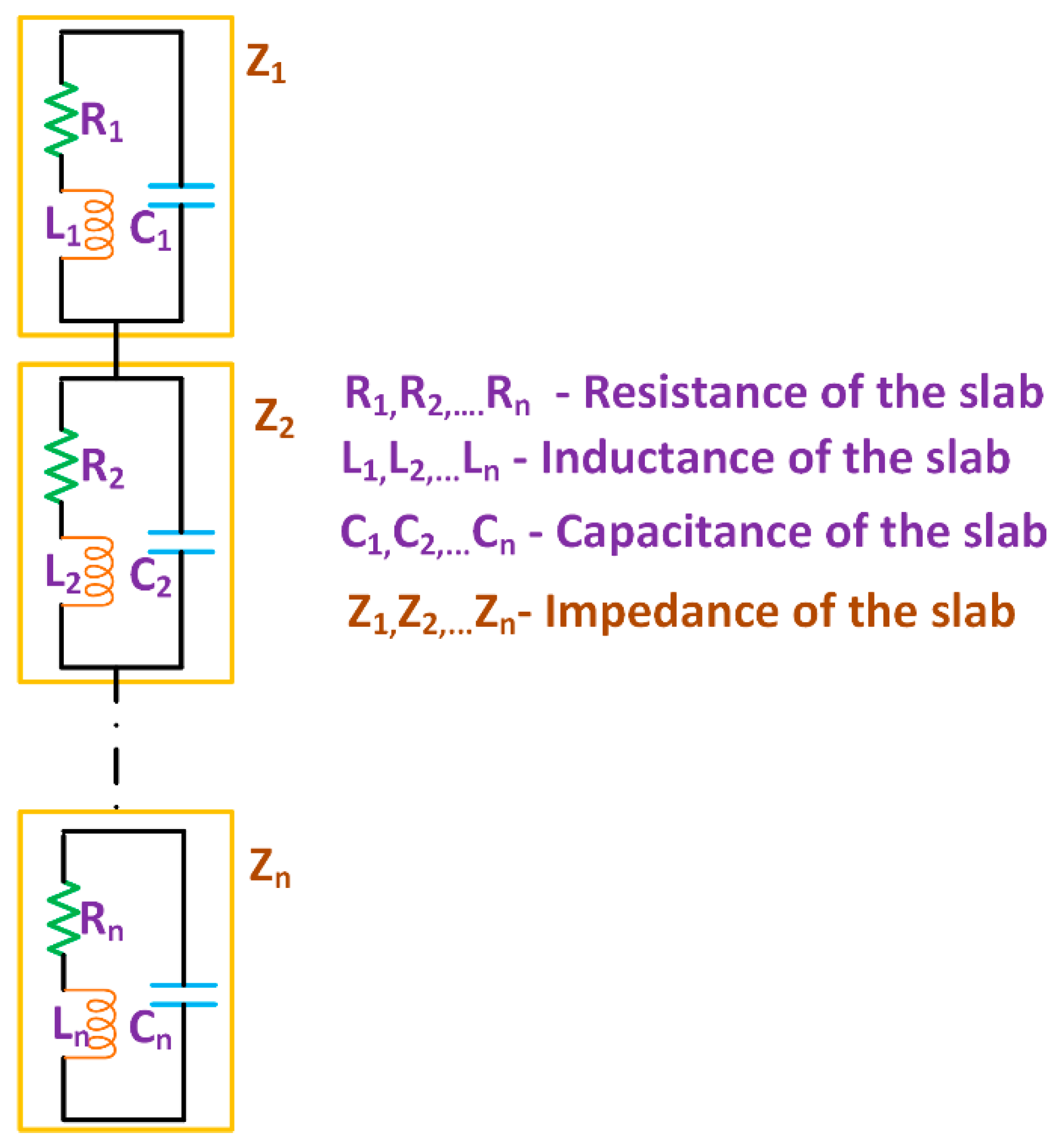
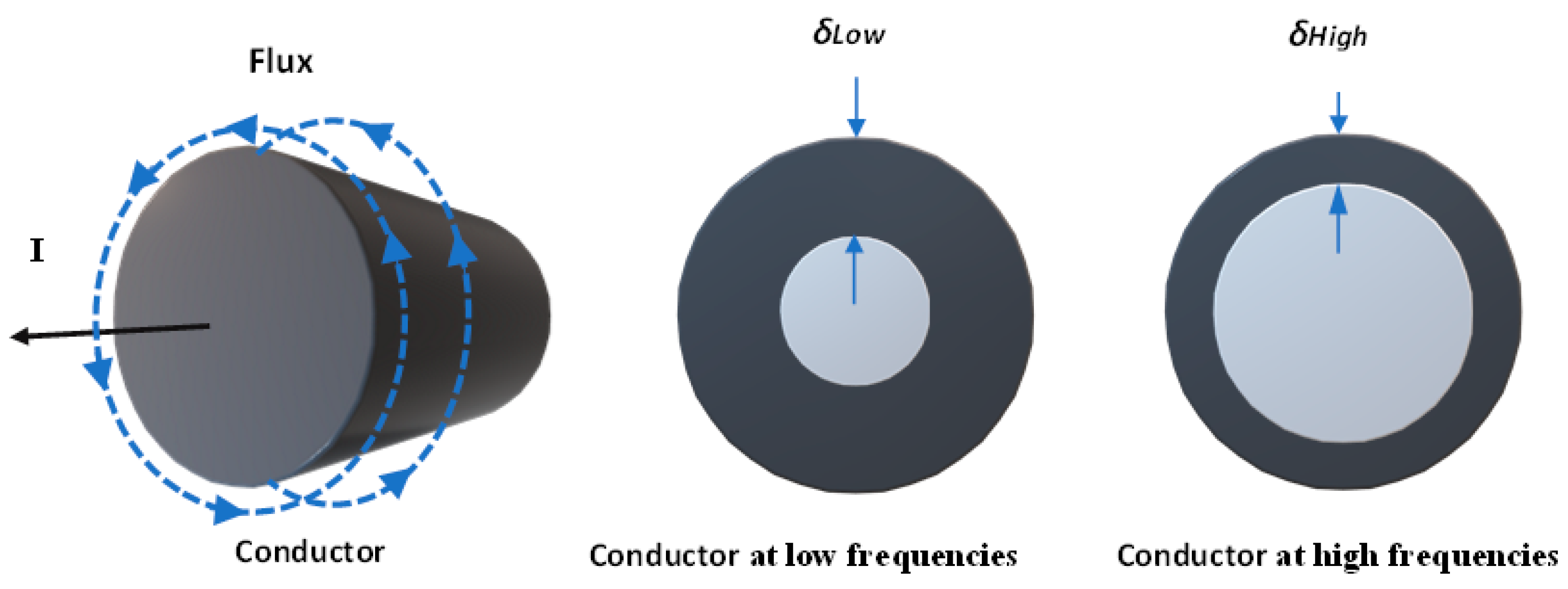

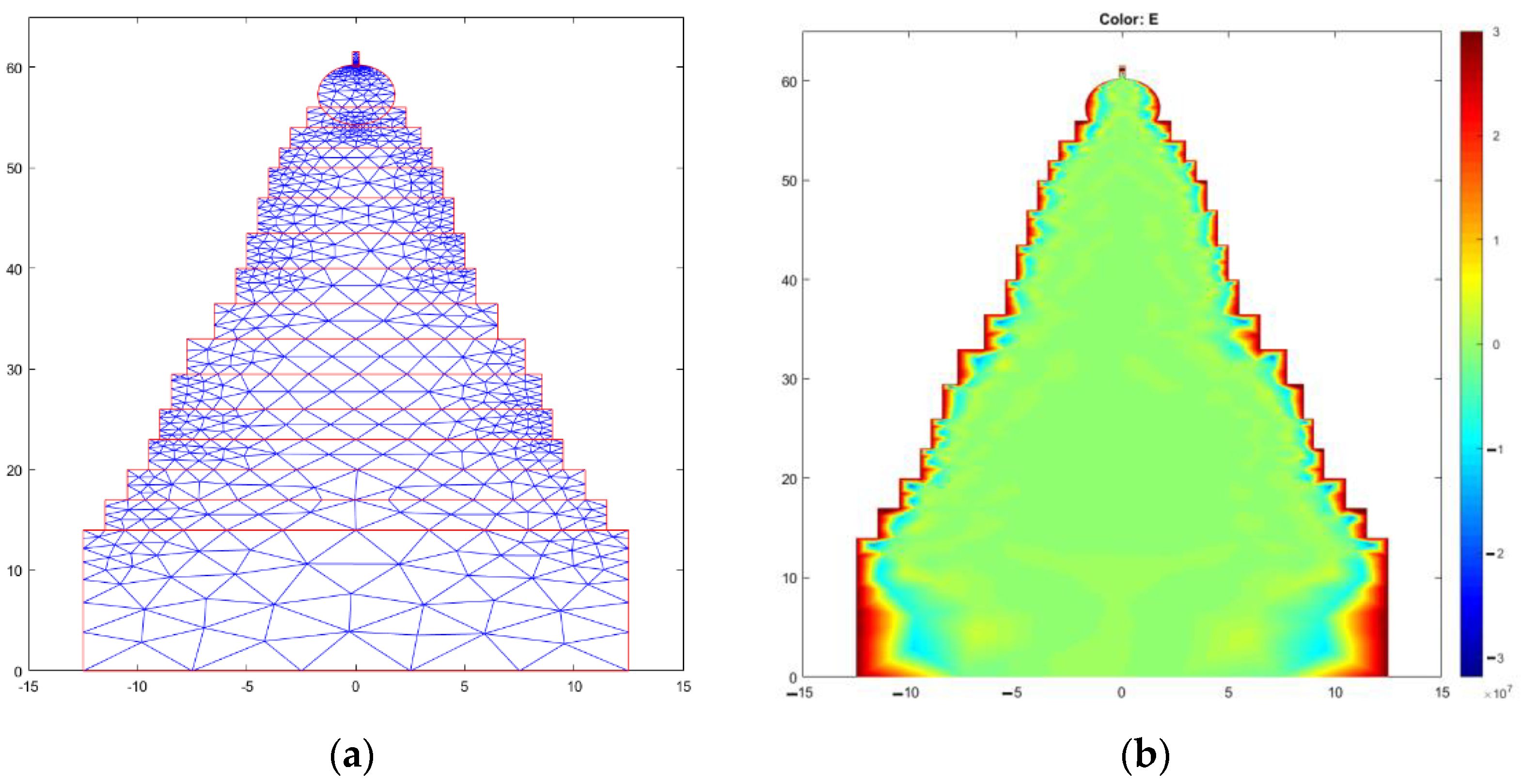



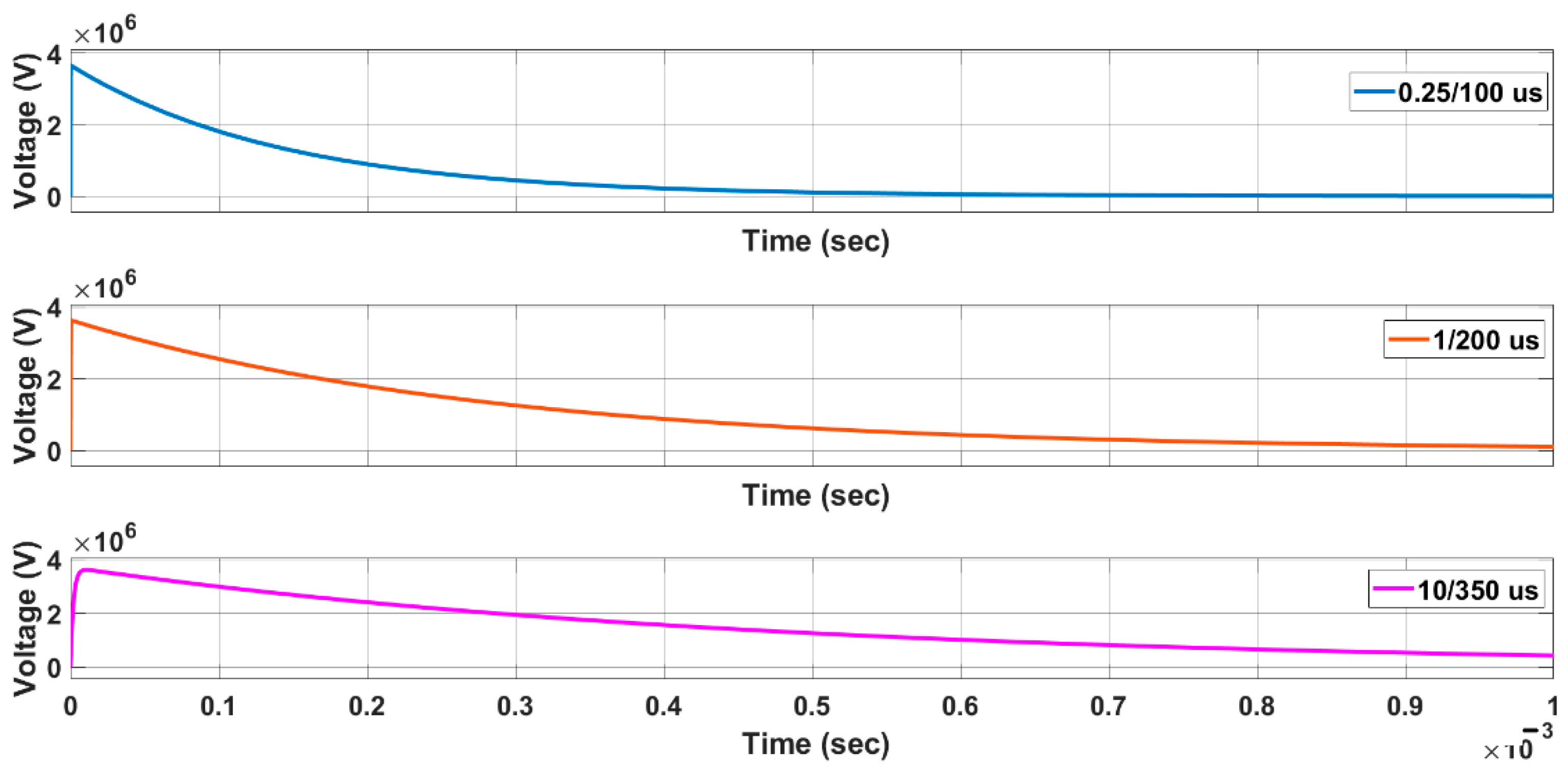

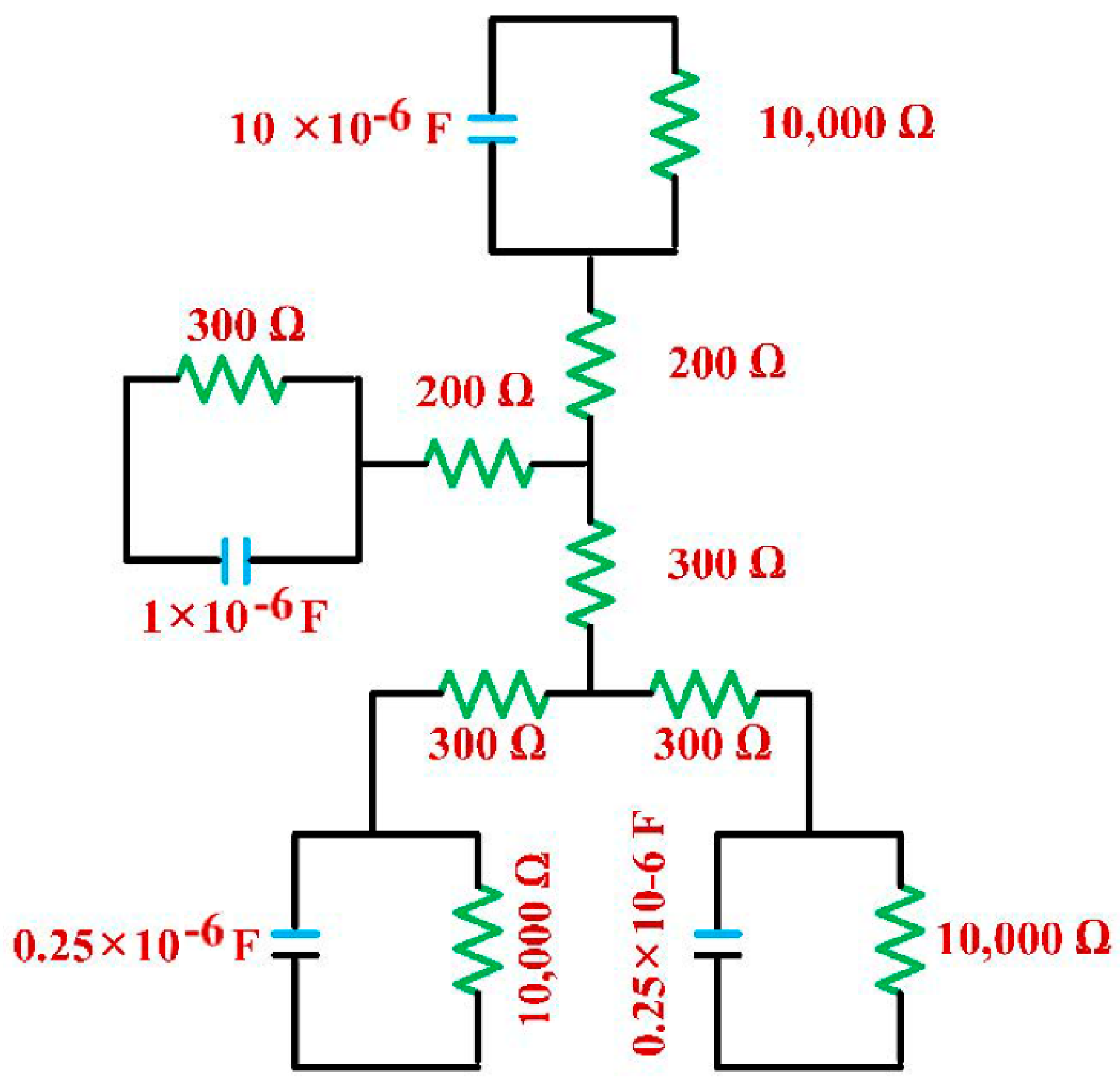



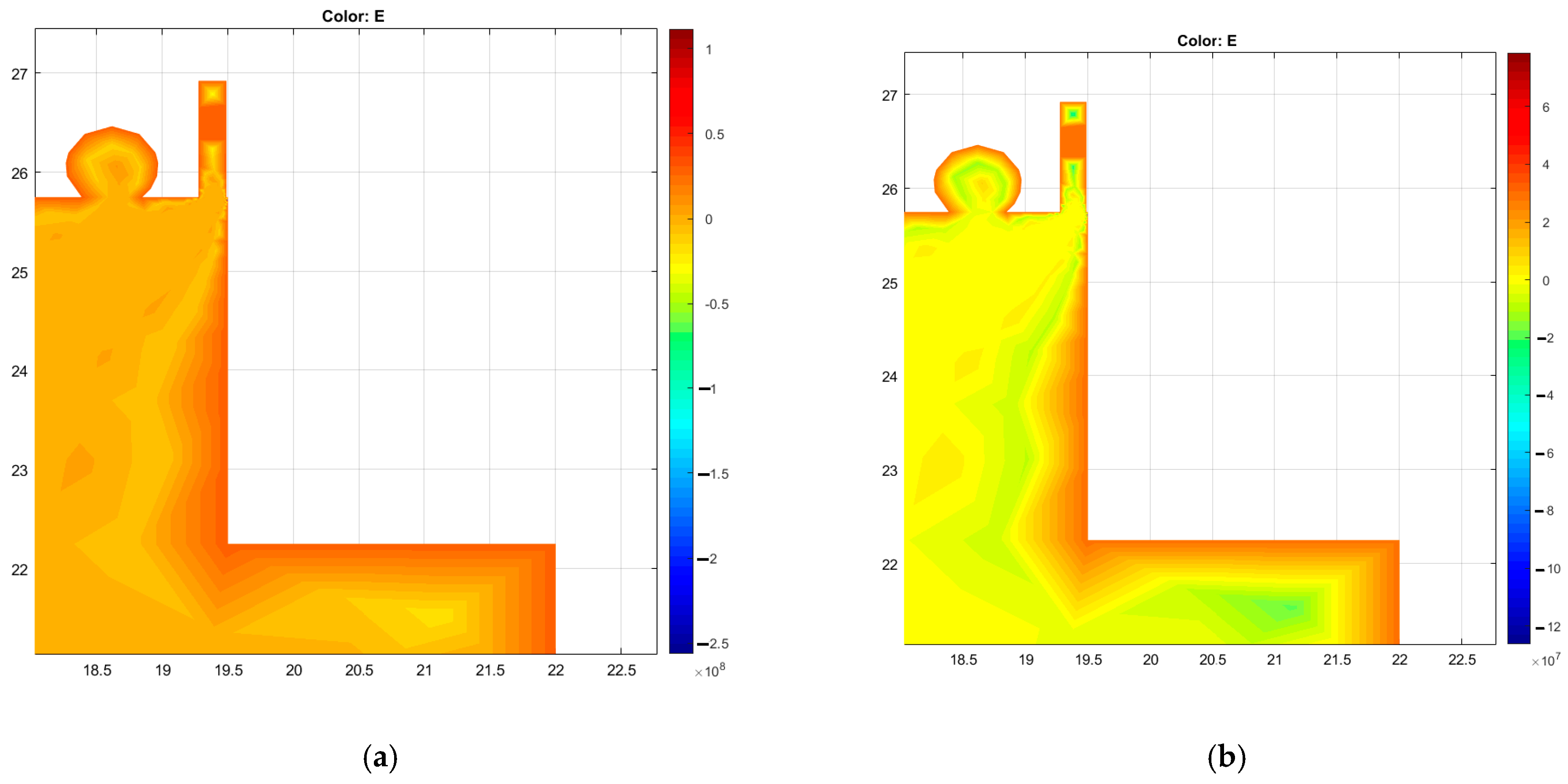
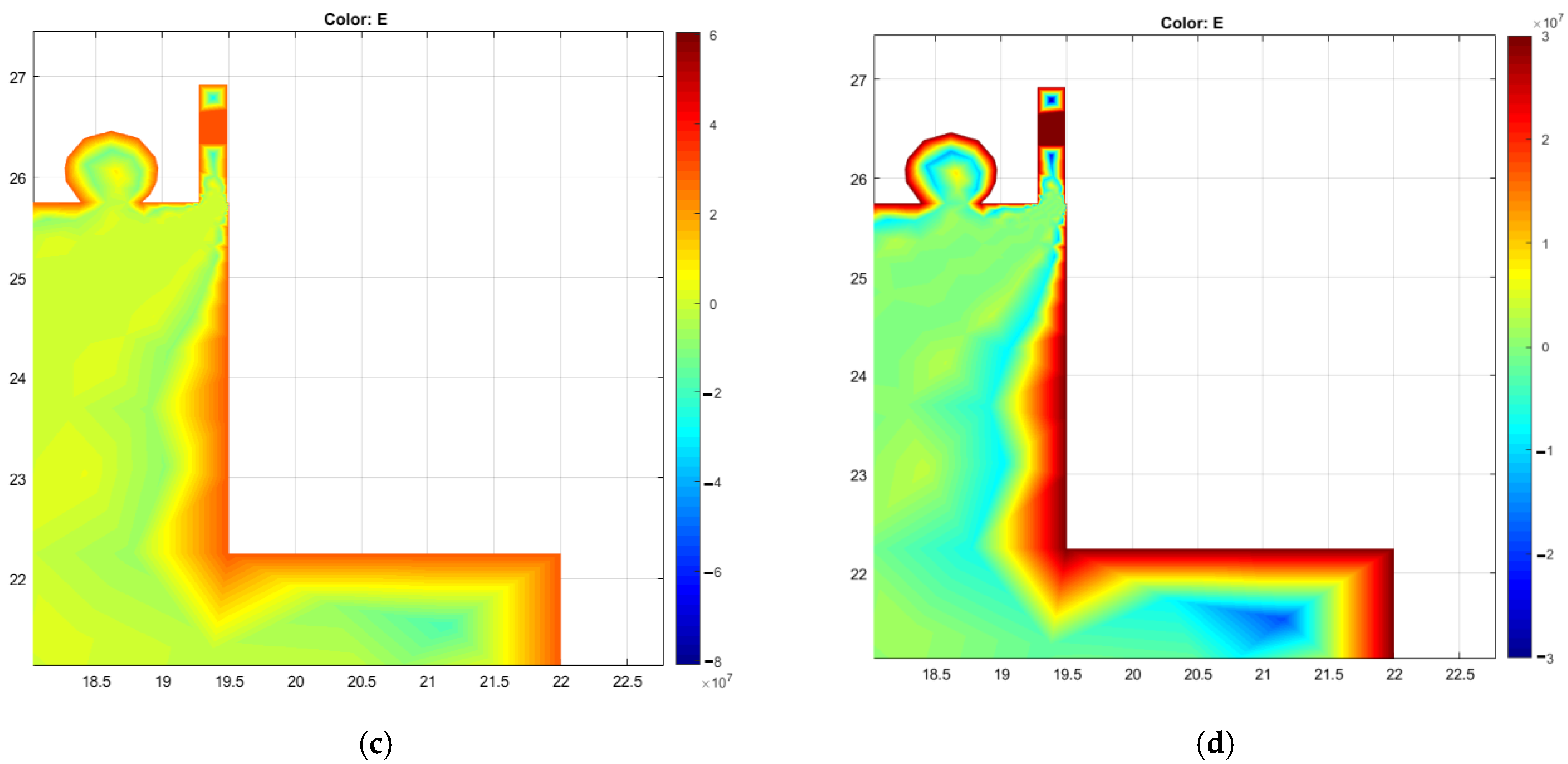
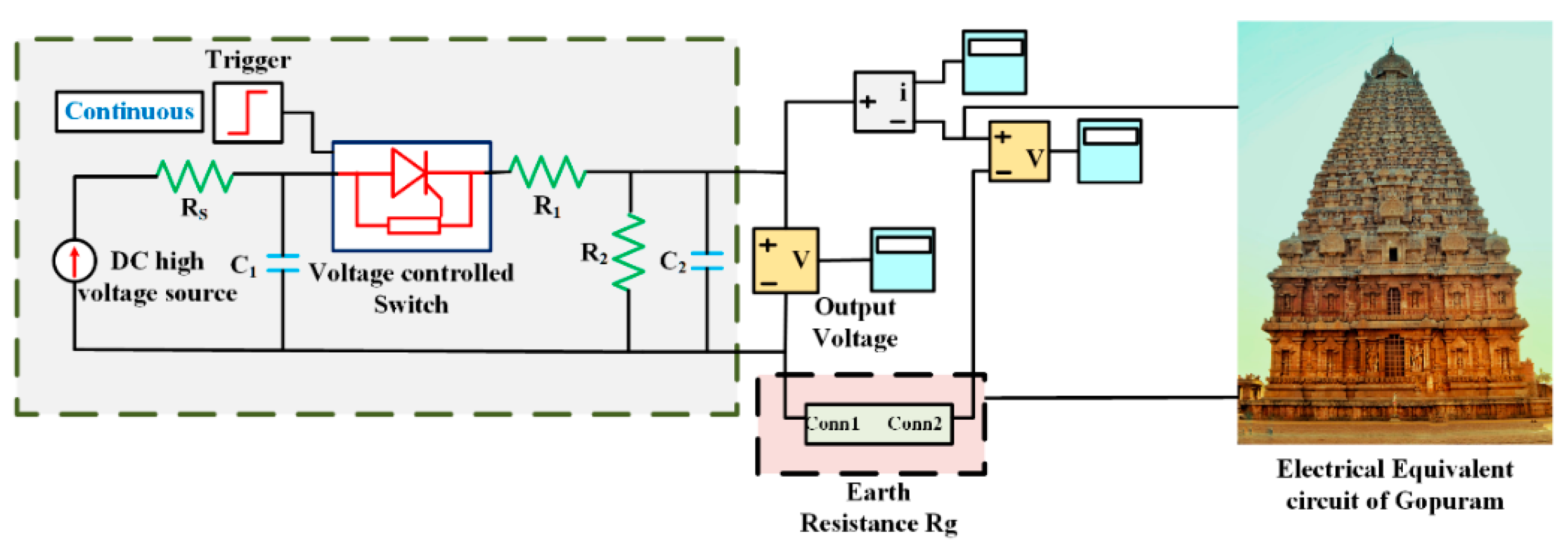


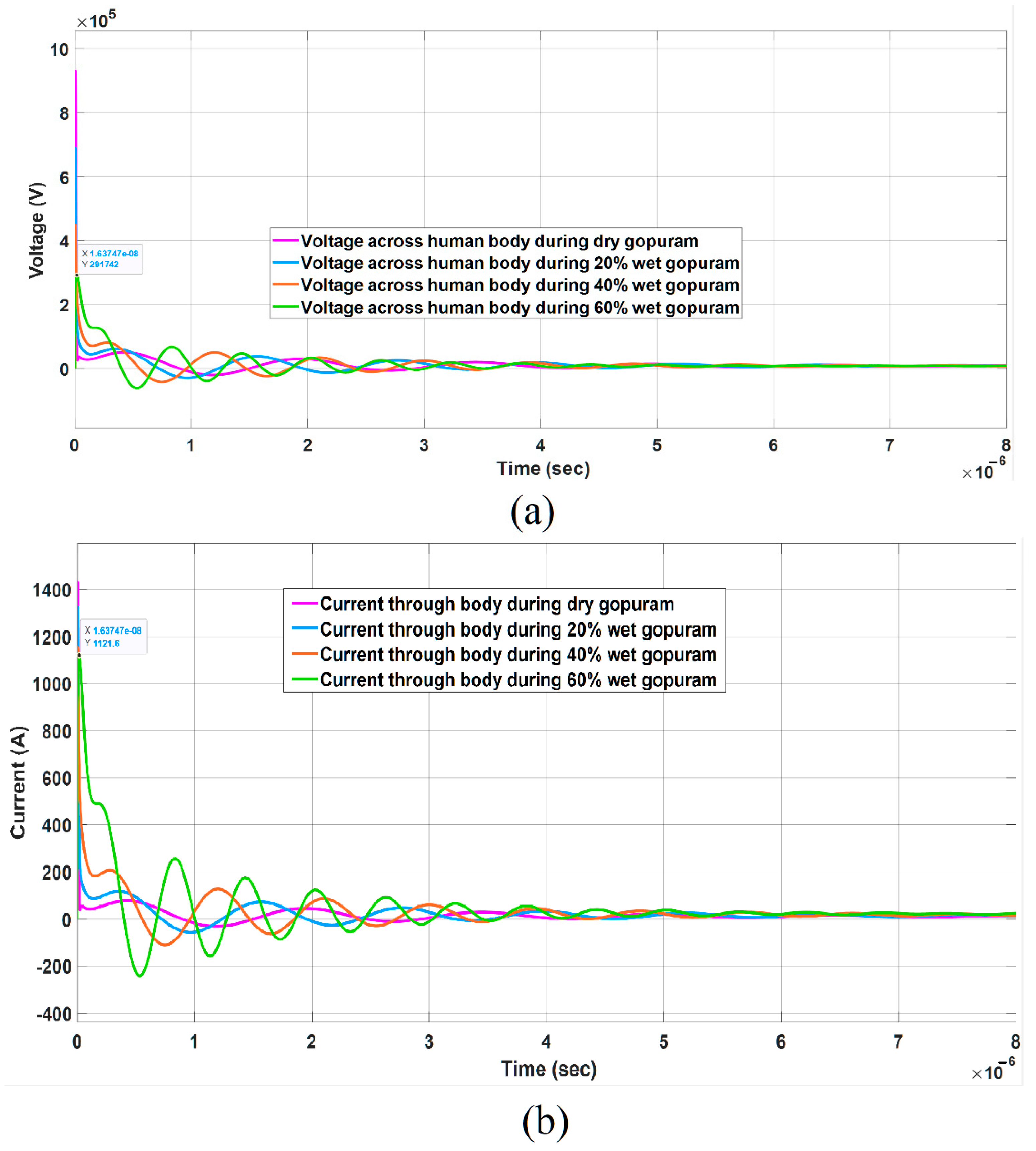
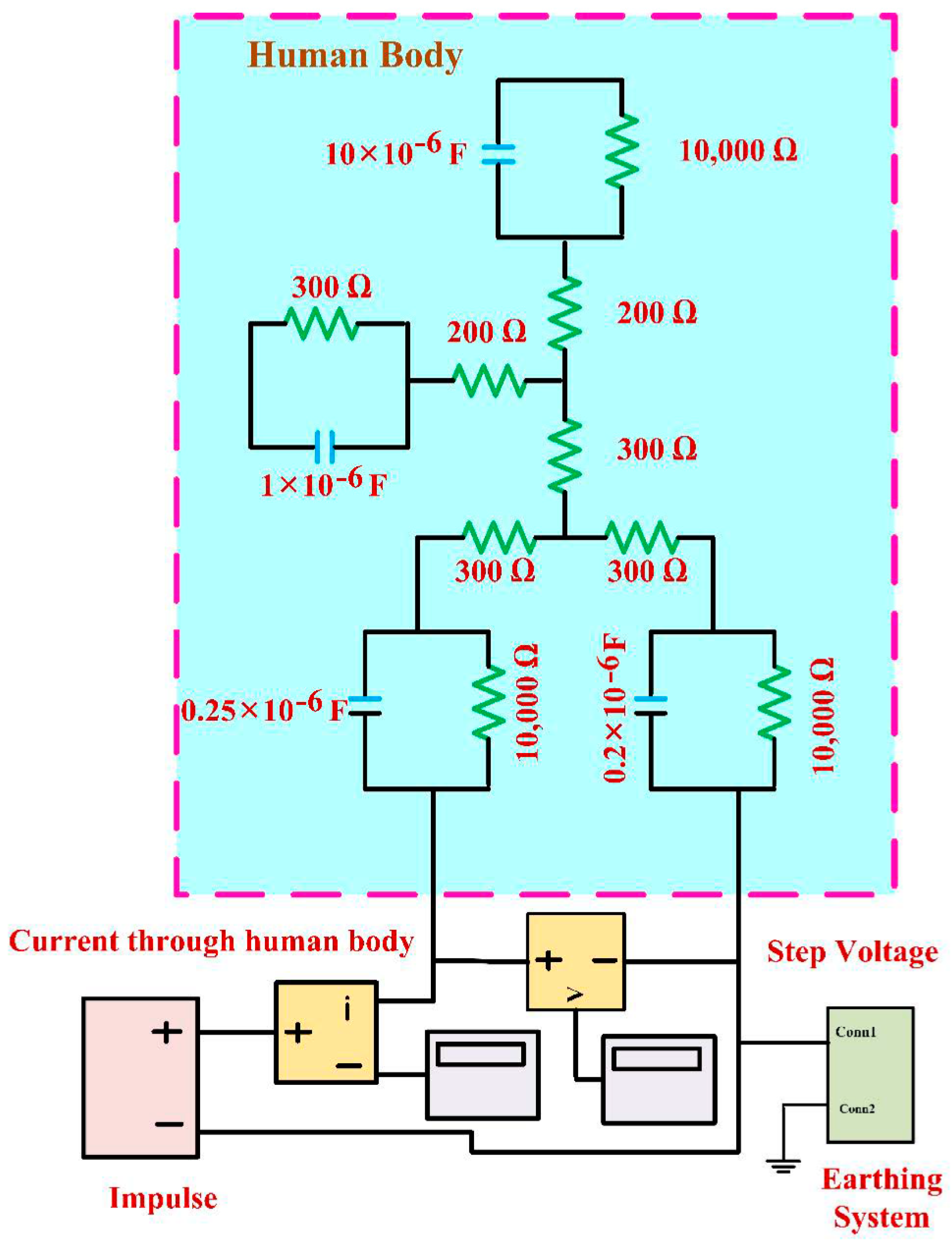
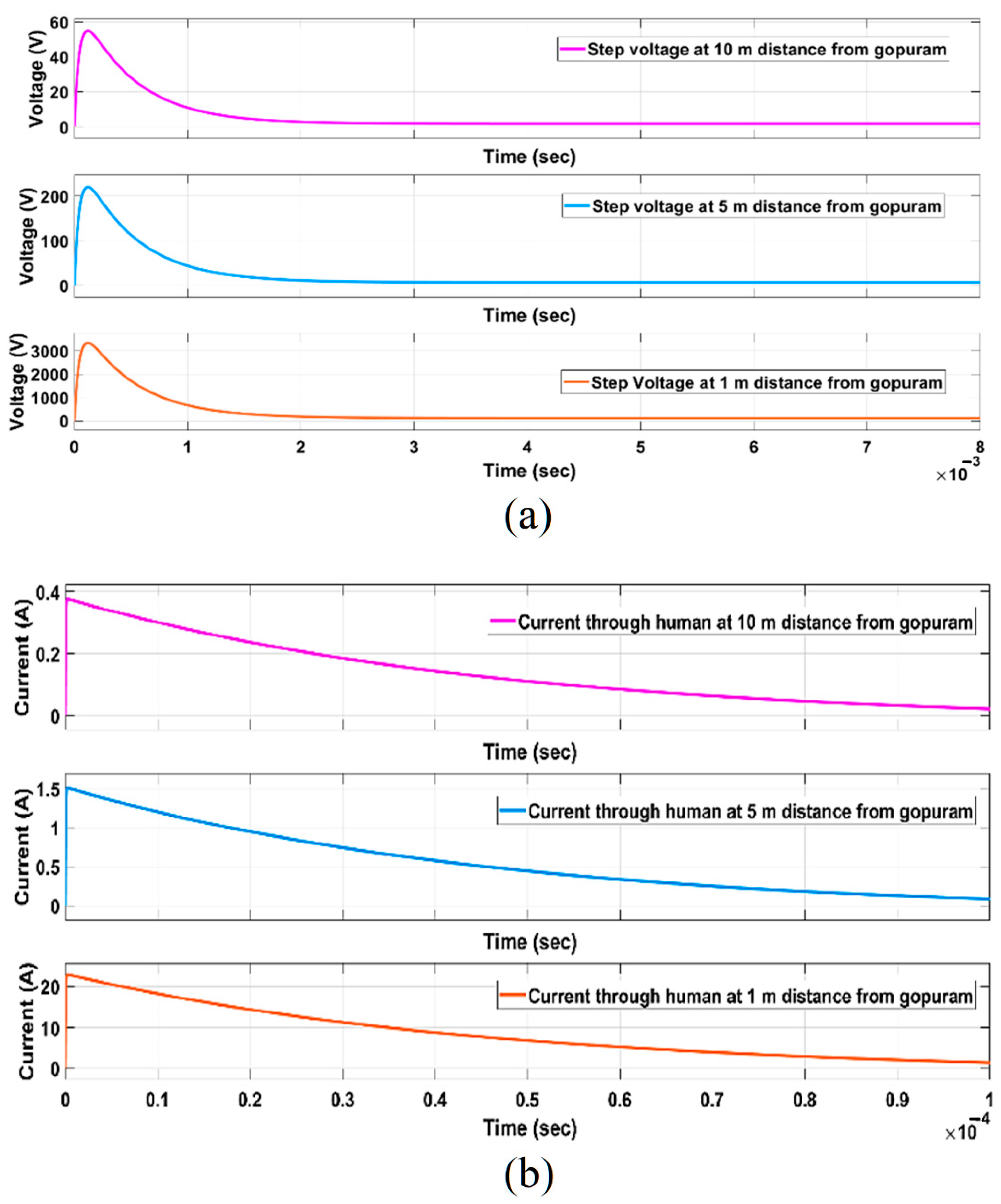
| S. No. | Length (mm) | Width (mm) | Height (mm) | Overall Height (mm) | Inductance (µH) | Resistance (Ω) | Capacitance(F) |
|---|---|---|---|---|---|---|---|
| 1 | 25,000 | 25,000 | 14,500 | 14,500 | 4.267019592 | 23.2 | 1.91 × 10−9 |
| 2 | 23,000 | 23,000 | 5000 | 19,500 | 3.553363837 | 9.4518 | 4.68 × 10−9 |
| 3 | 21,000 | 21,000 | 3000 | 22,500 | 3.174662949 | 6.8024 | 6.51 × 10−9 |
| 4 | 19,000 | 19,000 | 3000 | 25,500 | 2.885221468 | 8.3102 | 5.33 × 10−9 |
| 5 | 18,000 | 18,000 | 3000 | 28,500 | 2.740498504 | 9.2593 | 4.78 × 10−9 |
| 6 | 17,000 | 17,000 | 3000 | 31,500 | 2.5957738 | 10.381 | 4.26 × 10−9 |
| 7 | 15,500 | 15,500 | 3000 | 34,500 | 2.378682941 | 12.487 | 3.55 × 10−9 |
| 8 | 13,000 | 13,000 | 3000 | 37,500 | 2.016851951 | 17.751 | 2.49 × 10−9 |
| 9 | 11,000 | 11,000 | 3000 | 40,500 | 1.72737124 | 24.79 | 1.79 × 10−9 |
| 10 | 10,000 | 10,000 | 3000 | 43,500 | 1.582623613 | 30 | 1.48 × 10−9 |
| 11 | 9000 | 9000 | 3000 | 46,500 | 1.437869719 | 37.037 | 1.20 × 10−9 |
| 12 | 8000 | 8000 | 3000 | 49,500 | 1.29310805 | 46.875 | 9.44 × 10−10 |
| 13 | 7000 | 7000 | 3000 | 52,500 | 1.148336554 | 61.224 | 7.23 × 10−10 |
| 14 | 6000 | 6000 | 2500 | 55,000 | 0.981276023 | 69.444 | 6.38 × 10−10 |
| 15 | 5000 | 5000 | 2000 | 57,000 | 0.814215763 | 80 | 5.53 × 10−10 |
| Impulse Waveshapes | Values of Wave Shaping Components | |||
|---|---|---|---|---|
| R1 (Ω) | R2 (Ω) | C1 (F) | C2 (F) | |
| 0.25/100 µs | 5 | 1300 | 0.1 × 10−6 | 9 × 10−9 |
| 1/200 µs | 5.5 | 300 | 0.9 × 10−6 | 25 × 10−9 |
| 10/350 µs | 100 | 650 | 0.6 × 10−6 | 23 × 10−6 |
| S. No. | Frequency | Depth of Penetration |
|---|---|---|
| 1 | 5 kHz | <1 m |
| 2 | 50 kHz | 0.8 m to 1 m |
| 3 | 100 kHz | 0.7 m |
| 4 | 500 kHz | 0.5 m |
| 5 | 1000 kHz | 0.3 m |
| 10/350 µs | ||||||||
|---|---|---|---|---|---|---|---|---|
| Single Layer Model | ||||||||
(20% Wet) MV | (20% Wet) Amps | (40% Wet) MV | (40% Wet) Amps | (60% Wet) MV | (60% Wet) Amps | |||
| Resistive Earthing | 36.548 | 3144.31 | 36.543 | 3942.46 | 36.534 | 5261.87 | 36.517 | 7913.19 |
| Lumped RC Earthing | 36.548 | 3158.11 | 36.543 | 3945.84 | 36.546 | 5267.89 | 36.517 | 7926.81 |
| Lumped RLC earthing | 36.547 | 3158.03 | 36.543 | 3945.84 | 36.534 | 5267.86 | 36.517 | 7926.88 |
| Double layer model | ||||||||
| Resistive Earthing | 36.548 | 3145.9 | 36.543 | 3942.91 | 36.534 | 5262.69 | 36.517 | 7914.86 |
| Lumped RC Earthing | 36.548 | 3158.08 | 36.547 | 3946.37 | 36.534 | 5267.93 | 36.517 | 7926.73 |
| Lumped RLC earthing | 36.547 | 3158.01 | 36.543 | 3945.84 | 36.534 | 5267.91 | 36.517 | 7926.8 |
| 1/200 µs | ||||||||
|---|---|---|---|---|---|---|---|---|
| Single Layer Model | ||||||||
(20% Wet) MV | (20% Wet) Amps | (40% Wet) MV | (40% Wet) Amps | (60% Wet) MV | (60% Wet) Amps | |||
| Resistive Earthing | 36.578 | 3152.78 | 36.575 | 3922.9 | 36.568 | 5217.14 | 36.556 | 7885.75 |
| Lumped RC Earthing | 36.578 | 3167.62 | 36.575 | 3928.61 | 36.568 | 5228.12 | 36.555 | 7920.25 |
| Lumped RLC earthing | 36.576 | 3168.13 | 36.575 | 3929.72 | 36.568 | 5228.91 | 36.555 | 7924.56 |
| Double layer model | ||||||||
| Resistive Earthing | 36.57 | 3154.07 | 36.566 | 3922.59 | 36.560 | 5218.33 | 36.547 | 7896.77 |
| Lumped RC Earthing | 36.57 | 3168.23 | 36.566 | 3929.5 | 36.56 | 5229.49 | 36.547 | 7928.59 |
| Lumped RLC earthing | 36.569 | 3168.72 | 36.566 | 3930.3 | 36.56 | 5229.72 | 36.547 | 7929.73 |
| 0.25/100 µs | ||||||||
|---|---|---|---|---|---|---|---|---|
| Single Layer Model | ||||||||
(20% Wet) MV | (20% Wet) Amps | (40% Wet) MV | (40% Wet) Amps | (60% Wet) MV | (60% Wet) Amps | |||
| Resistive Earthing | 36.552 | 3147.48 | 36.404 | 3931.19 | 36.163 | 5206.85 | 36.692 | 7703.63 |
| Lumped RC Earthing | 36.551 | 3161.09 | 36.403 | 3934.49 | 36.162 | 5212.65 | 36.69 | 7716.35 |
| Lumped RLC earthing | 36.551 | 3161.01 | 36.403 | 3934.49 | 36.162 | 5212.65 | 36.69 | 7716.34 |
| Double layer model | ||||||||
| Resistive Earthing | 36.552 | 3149.16 | 36.404 | 3931.72 | 36.164 | 5207.55 | 36.692 | 7705.16 |
| Lumped RC Earthing | 36.55 | 3161.18 | 36.404 | 3934.6 | 36.163 | 5212.6 | 36.69 | 7716.23 |
| Lumped RLC earthing | 36.55 | 3161.1 | 36.404 | 3934.6 | 36.162 | 5212.47 | 36.69 | 7716.23 |
| Impulse Wave Shape | Dry | 20% Wetness | 40% Wetness | 60% Wetness | ||||
|---|---|---|---|---|---|---|---|---|
| 10/350 µs | 2,744,930 | 2990.16 | 3,438,410 | 3717.91 | 4,432,750 | 4916.71 | 5,112,890 | 7239.15 |
| 1/200 µs | 2,026,120 | 2988.89 | 2,445,350 | 3725.76 | 3,220,540 | 4994.44 | 4,678,590 | 7501.02 |
| 0.25/100 µs | 1,992,250 | 3052.51 | 1,997,020 | 3825.48 | 2,396,980 | 5107.96 | 3,455,130 | 7624.1 |
| 10/350 µs | ||||||||||||||||
|---|---|---|---|---|---|---|---|---|---|---|---|---|---|---|---|---|
| Single Layer Soil | ||||||||||||||||
| Resistive Earthing | 36.648 | 2859.881 | 193,456 | 297.119 | 36.644 | 3757.96 | 89,201.4 | 171.24 | 36.638 | 4941.128 | 113,161 | 289.472 | 36.624 | 7333.412 | 153672 | 588.728 |
| Lumped RC Earthing | 36.647 | 3093.996 | 49,711.2 | 75.264 | 36.644 | 3817.465 | 53,505.9 | 114.845 | 36.638 | 5043.926 | 75,079.5 | 192.094 | 36.624 | 7548.506 | 100,644 | 385.834 |
| Lumped RLC earthing | 36.647 | 1737.44 | 930,665 | 1431.77 | 36.644 | 2608.32 | 688,354 | 1323.73 | 36.638 | 4081.69 | 449,722 | 1153.1 | 36.624 | 6806.77 | 291,745 | 1121.61 |
| Double layer Soil | ||||||||||||||||
| Resistive Earthing | 36.648 | 2888.302 | 177,716 | 272.918 | 36.644 | 3772.048 | 85,466.5 | 164.072 | 36.638 | 4968.153 | 108,319 | 277.097 | 36.624 | 7382.828 | 147,028 | 563.382 |
| Lumped RC Earthing | 36.647 | 3108.707 | 49,726.6 | 76.413 | 36.644 | 3853.679 | 59,812.8 | 114.851 | 36.638 | 5120.344 | 75,175.4 | 192.366 | 36.624 | 7647.624 | 100,599 | 385.706 |
| Lumped RLC earthing | 36.647 | 1754.78 | 930,825 | 1430.26 | 36.644 | 2644.53 | 688,342 | 1323.71 | 36.638 | 4160.73 | 449,739 | 1150.76 | 36.624 | 6906.69 | 291,750 | 1121.63 |
| 1/200 µs | ||||||||||||||||
|---|---|---|---|---|---|---|---|---|---|---|---|---|---|---|---|---|
| Single Layer Soil | ||||||||||||||||
| Resistive Earthing | 36.548 | 2861.34 | 184,944 | 283.95 | 36.543 | 3786.712 | 80,959.4 | 155.418 | 36.534 | 5009.25 | 98,764 | 252.55 | 36.517 | 7433.499 | 125,399 | 480.211 |
| Lumped RC Earthing | 36.548 | 3088.55 | 45,332.7 | 69.650 | 36.543 | 3844.244 | 52,913.4 | 101.286 | 36.534 | 5135.107 | 63,233.1 | 132.543 | 36.517 | 7624.918 | 78,800 | 301.922 |
| Lumped RLC earthing | 36.547 | 2441.102 | 466,319 | 716.938 | 36.543 | 3285.705 | 343,895 | 659.835 | 36.534 | 4693.713 | 224072 | 574.527 | 36.517 | 7299.891 | 162,760 | 625.099 |
| Double layer Soil | ||||||||||||||||
| Resistive Earthing | 36.548 | 2872.339 | 169,570 | 360.371 | 36.543 | 3794.036 | 77,387.8 | 148.534 | 36.534 | 5021.394 | 94,284.5 | 241.136 | 36.517 | 7458.516 | 119,533 | 456.864 |
| Lumped RC Earthing | 36.548 | 3088.533 | 45,342.8 | 69.667 | 36.543 | 3844.919 | 52,924.7 | 101.611 | 36.534 | 5136.118 | 63,531.9 | 162.522 | 36.517 | 7624.165 | 78,987.8 | 302.695 |
| Lumped RLC earthing | 36.547 | 2433.061 | 467,440 | 719.129 | 36.543 | 3285.581 | 343,705 | 660.959 | 36.534 | 4693.653 | 223,890 | 625.577 | 36.517 | 7350.316 | 162,660 | 574.694 |
| 0.25/100 µs | ||||||||||||||||
|---|---|---|---|---|---|---|---|---|---|---|---|---|---|---|---|---|
| Single Layer Soil | ||||||||||||||||
| Resistive Earthing | 36.551 | 2915.325 | 156,722 | 233.165 | 36.404 | 3858.3978 | 39,568.7 | 72.8122 | 36.163 | 5089.916 | 49,213.3 | 117.094 | 36.692 | 7478.034 | 68,165.7 | 226.066 |
| Lumped RC Earthing | 36.549 | 3142.503 | 12,085.1 | 18.557 | 36.403 | 3911.228 | 12,104 | 23.222 | 36.162 | 5181.7474 | 12,093 | 30.9126 | 36.69 | 7670.5986 | 11,966.3 | 45.8214 |
| Lumped RLC earthing | 36.548 | 3107.898 | 34,477.4 | 53.072 | 36.403 | 3885.6953 | 25,335.4 | 48.7547 | 36.162 | 5170.381 | 20,330.42 | 42.289 | 36.69 | 7619.751 | 16,489.9 | 96.669 |
| Double layer Soil | ||||||||||||||||
| Resistive Earthing | 36.551 | 2940.867 | 140,490 | 209.013 | 36.404 | 3865.928 | 35,681.5 | 65.702 | 36.163 | 5102.823 | 44,108.1 | 104.907 | 36.692 | 7504.157 | 60,676.9 | 201.493 |
| Lumped RC Earthing | 36.551 | 3142.649 | 12,086.8 | 18.561 | 36.404 | 3911.4139 | 12,105.1 | 23.2261 | 36.163 | 5181.6733 | 12,089.2 | 30.9067 | 36.690 | 7670.419 | 11,966.7 | 45.811 |
| Lumped RLC earthing | 36.551 | 3108.033 | 34,513.6 | 53.097 | 36.405 | 3886.141 | 25,234.9 | 48.309 | 36.163 | 5170.755 | 21,918.1 | 51.905 | 36.690 | 7619.586 | 20,329.1 | 96.654 |
| Rhuman at 60% Wetness | Impulse Waveshape | Soil Model | Earthing System | Ipeak (A) | Ihalf (A) | Thalf (Sec) | Energy (J) |
|---|---|---|---|---|---|---|---|
| 4000 Ω | 10/350 µs | Single layer soil | R | 588.728 | 294.364 | 124.78 | |
| R-L-C | 1121.61 | 560.805 | 150.96 | ||||
| Double layer soil | R | 563.382 | 281.691 | 113.95 | |||
| R-L-C | 1121.63 | 560.815 | 150.97 | ||||
| 1/200 µs | Single layer soil | R | 480.211 | 240.1055 | 93.163 | ||
| R-L-C | 625.099 | 312.5495 | 132.85 | ||||
| Double layer soil | R | 456.864 | 228.432 | 84.325 | |||
| R-L-C | 574.694 | 287.347 | 112.29 | ||||
| 0.25/100 µs | Single layer soil | R | 226.066 | 113.033 | 1722.3 | ||
| R-L-C | 96.669 | 48.3345 | 110.27 | ||||
| Double layer soil | R | 201.493 | 100.7465 | 1356 | |||
| R-L-C | 96.654 | 48.327 | 110.24 |
| Distance (m) | Step Voltage (V) | Current (A) |
|---|---|---|
| 1 | 3352.35 | 22.9260 |
| 5 | 218.95 | 1.471 |
| 10 | 54.606 | 0.367 |
| Stroke Current Range (kA) | Unprotected Area (m2) | Probability of Stroke (%) | Expected Number of Failures (Failures/Year) |
|---|---|---|---|
| (5–18) | 9320 | 30.46 | 3.12 × 10−3 |
| (18–31) | 1580 | 33.92 | 5.90 × 10−4 |
| (31–44) | 4 | 16.82 | 7.40 × 10−7 |
| (44–57) | 0 | 7.59 | 0.00 |
| (57–70) | 0 | 3.72 | 0.00 |
| (70–83) | 0 | 2 | 0.00 |
| (83–96) | 0 | 1.17 | 0.00 |
| (96–109) | 0 | 0.73 | 0.00 |
| (109–122) | 0 | 0.48 | 0.00 |
| (122–135) | 0 | 0.33 | 0.00 |
| (135–148) | 0 | 0.23 | 0.00 |
| (148–161) | 0 | 0.17 | 0.00 |
| (161–174) | 0 | 0.13 | 0.00 |
| (174–187) | 0 | 0.1 | 0.00 |
| (187–200) | 0 | 0.08 | 0.00 |
Publisher’s Note: MDPI stays neutral with regard to jurisdictional claims in published maps and institutional affiliations. |
© 2022 by the authors. Licensee MDPI, Basel, Switzerland. This article is an open access article distributed under the terms and conditions of the Creative Commons Attribution (CC BY) license (https://creativecommons.org/licenses/by/4.0/).
Share and Cite
Sreedhar, S.; Indragandhi, V. A Comprehensive Framework for Direct Lightning-Structure-Human Interaction Modelling in Heritage Monuments and Safety Assessment. Energies 2022, 15, 7053. https://doi.org/10.3390/en15197053
Sreedhar S, Indragandhi V. A Comprehensive Framework for Direct Lightning-Structure-Human Interaction Modelling in Heritage Monuments and Safety Assessment. Energies. 2022; 15(19):7053. https://doi.org/10.3390/en15197053
Chicago/Turabian StyleSreedhar, Srisailam, and Vairavasundaram Indragandhi. 2022. "A Comprehensive Framework for Direct Lightning-Structure-Human Interaction Modelling in Heritage Monuments and Safety Assessment" Energies 15, no. 19: 7053. https://doi.org/10.3390/en15197053
APA StyleSreedhar, S., & Indragandhi, V. (2022). A Comprehensive Framework for Direct Lightning-Structure-Human Interaction Modelling in Heritage Monuments and Safety Assessment. Energies, 15(19), 7053. https://doi.org/10.3390/en15197053







